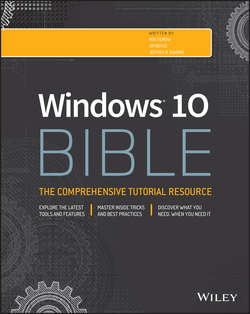Читать книгу Windows 10 Bible - Shapiro Jeffrey R. - Страница 12
На сайте Литреса книга снята с продажи.
Part I
Getting Started
Chapter 2
Navigating the Windows 10 Interface
Introducing the Windows 10 Interface
ОглавлениеThe interface introduced in Windows 8 and fine-tuned in Windows 8.1 represented a shift toward touch-based interaction with the Windows operating system and applications, driven in large part by the growth of the tablet and handheld device markets. Although Windows 10 continues that touch-based focus, the Windows 10 interface is not only about touch; it's also about simplification and putting data and applications within easy reach. In addition, Microsoft has melded the positive aspects of the new interface with the Start menu familiar to users of Windows 7 and earlier versions.
Figure 2.1 shows the Windows 10 logon screen, which you use to log in to the device. Although Chapter 3 explains how to log in and out of Windows, we cover it briefly here. Windows displays a list of user accounts available on the device (see Figure 2.1) with the most recently used account shown in the middle of the display. To log in with the most recently used account, just tap or click in the Password box, type the password for the account, and press Enter or tap the arrow key beside the Password box. To use a different account, tap (touch or click) on a user in the list at the left corner of the display, enter the password for that user account, and then press Enter or tap (or click) the arrow icon to the right of the password field.
Figure 2.1 The Windows 10 Logon screen.
If the device is locked but your account is logged on, Windows displays the logon screen shown in Figure 2.2. This is nearly identical to the logon screen in Figure 2.1, except only the currently logged on account is shown. As when logging on, just type your password and then press Enter or tap the arrow key.
Figure 2.2 The Windows 10 Lock screen.
After you log in, you see the Windows 10 desktop, shown in Figure 2.3. The desktop should be familiar to you, regardless of which version of Windows you have used previously, because the desktop is a key feature of all previous versions of Windows. However, the Windows 10 desktop is a little different from the others.
Figure 2.3 The Windows Start menu and desktop.
The first difference is the Start menu. To open the Start menu, click the Windows button at the left edge of the taskbar. As shown in Figure 2.3, the new Windows 10 Start menu is a melding of the Start menu found in Windows 7 and the Start screen found in Windows 8.x. On the left are frequently-used apps, settings, and folders, and on the right are tiles for apps. You can start an app just by clicking or tapping on its tile or in the list at the left of the Start menu.
Before we dig deeper into the Windows 10 interface and its elements, let's look at the gestures and actions you can use within the interface.
